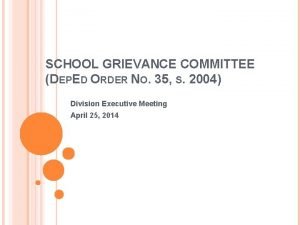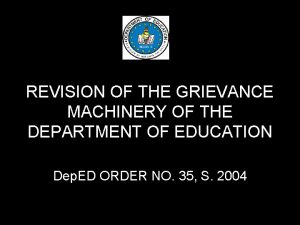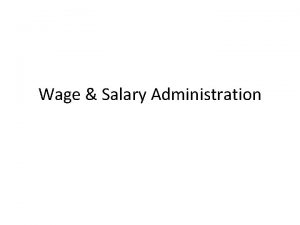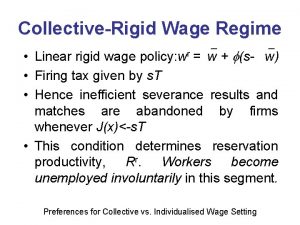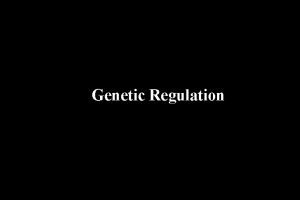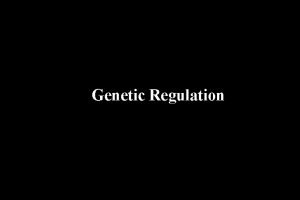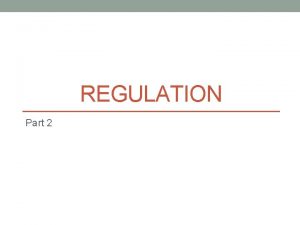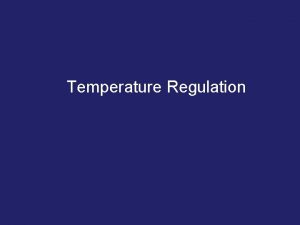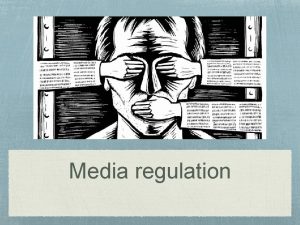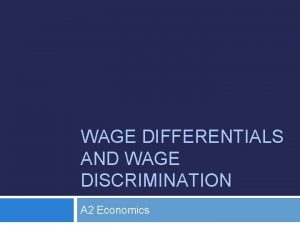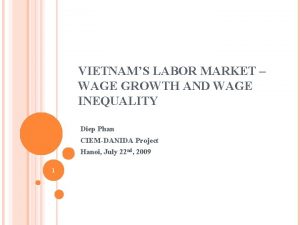Wage Policy And Wage Regulation Machinery Wage Concepts
























- Slides: 24

Wage Policy And Wage Regulation Machinery

Wage Concepts • Wages means all remuneration (salary, allowance etc) expressed in terms of money. • It also includes: – Any remuneration payable under any award or settlement between the parties or order of court. – Any additional remuneration payable under the terms of employment such as bonus and any sum by reason of termination of employment of person employed is payable under the law or contract of service. • The term “wages” may be used to describe wage rates, straight-time average/hourly earnings, gross average hourly earnings, weekly take-home pay and annual earnings. Other types of benefits as well as pensions, welfare funds, social security, vacations and holidays, are regarded as fringe benefits. They are paid in addition to wages and form part of the total labour costs. • To cultivate harmonious industrial relations the government (by enacting suitable labour legislations establishing wage boards etc), the employers and trade unions (by collective bargaining agreements) and the industrial jurisprudence (by giving suitable awards) have tried to implement a fair and reasonable wage structure for the country based on wage differentials.

Minimum Wages • A minimum wage is the lowest hourly, daily or monthly remuneration that employers may legally pay to workers. The conception of minimum wages is based on the principles of equity and social justice. Its underlying idea is that “he who works is entitled to a fair remuneration which may enable him to live a life consistent with human dignity”. • Several countries have enacted a statutory minimum wage rate that sets a price floor for certain kinds of labor. Legislative protection for workers to receive a minimum wage, can be considered as the hall mark of any progressive nation. It is one of the fundamental premises of decent work. In India, the Minimum Wages Act, 1948 provides for fixation and enforcement of minimum wages in respect of scheduled employments. • The Act aims to prevent sweating or exploitation of labour. The Act also requires the appropriate government (both at Centre and States) to fix minimum rates of wages in respect of employments specified in the schedule and also review and revise the same at intervals not exceeding five years. • With effect from November 2009, the National Floor Level of Minimum Wage has been increased to Rs 100 per day from Rs 80 per day (which was in effect since 2007).

Need-based Minimum wage i. In calculating the minimum wage, the standard working-class family should be taken to consist of three consumption units for one earner; the earnings of women, children and adolescents should be disregarded. nts nimum ii. iv. a net intake of 2700 calories for an average Indian moderate activity. adult of consumption of 18 yards per annum which could give for the average worker’s family of four, a total of 72 yards. charged houses provided for area Government any by the in under the subsidized industrial housing scheme for low-income groups; and v. Fuel, lighting and other miscellaneous items of expenditure should constitute 20 per cent of the total minimum wage. ”

Living Wage • Living wage as that appropriate for “the normal needs of the average employee, regarded as a human being living in a civilised community”. i. e. The living wage must provide not merely for absolute essentials such as food, shelter and clothing but for “a condition of frugal comfort estimated by current human standards”. • There are three possible ways of obtaining some indication as to what constitutes a living wage. – (i) It should be sufficient to purchase the minimum theoretical needs of a typical family, calculated in accordance with some more or less scientific formula. – (ii) It should be sufficient to pay for a satisfactory basic budget, as revealed by a survey of actual family expenditures. – (iii) It should be comparable with a living wage already established in similar circumstances.

Wage Policy • Wage policy are principles acting as guideline for determining a wage structure, legislation or government action calculated to affect the level or structure of wages, or both for the purpose of attaining specific objectives of social and economic policies • Initially as an economic issue it was mainly the concern of the employer while the state was adopting the laissez faire policy. But with the industrial progress and subsequent industrial balance between employers, employees, wage bargain has become a matter for three fold concern of the employer, employee and the state. • Wage policy is a democratic set up so that it can be enforced by the govt. alone. Its implementation has to be secured through employers and employees organisations at bargaining table. i. e. by consensus

The wage policy may be viewed from 3 angles: – At the macro economic level, the problem is that of resolving the conflict between the objectives of an immediate rise in the standard of living of workers, additional employment and capital formation – At the semi aggregate level, the problem is that of evolving a wage structure which promotes economic development – At the plant level, the problem is that of a system which provides incentives for increased productivity and improved skills.

Economic Objectives of wage policy • An important objective of any society is the achievement of maximum economic welfare. • In general, economic welfare will be maximized if the highest and most stable standard of living possible for each section of the community is attained. • In order to secure this, it is necessary to achieve: – Full employment and optimum allocation of all resources – The highest degree of economic stability consistent with an optimum rate of economic progress – Maximum income security for all sections of the society • The major objectives of wage policy must be aimed at attaining these conditions.

Social Objectives of wage policy • A given wage policy must be instrumental in achieving: – The elimination of exceptionally low wages – The establishment of ‘fair’ labour standards – The protection of wage earners from the effects of rising prices – The incentives for workers to improve their productive performance

Objectives of a Wage Policy (By ILO) • To abolish malpractices and abuses in wage payment • To set minimum wages for unorganised workers having weak bargaining powers • To provide for the workers a just share in the economic development. • To bring an efficient allocation and utilisation of manpower through wage differentials.

Objectives of a Wage Policy (India) 1. To provide a minimum wage to workers employed in sweated industries 2. To fix wage ceilings 3. To improve the existing wage structure 4. To control inflationary tendencies 5. To accelerate export promotion 6. Others 1. 2. 3. 4. To bring social justice and equal opportunities to workers To maintain industrial peace To provide guidance to wage fixation & revision authorities To develop the skills of newly recruited industrial labour and other manpower resources

In India wage policy is built around certain cardinal principles • Equal pay for equal work • Living wages for all workers so that they live a decent wage • Payment of wages on appointed dates without unauthorised deductions • Resolving wage related issues through collective bargaining • Payment of statutory bonus at 8. 33% as per legal provisions • Ensuring a fair, equitable wage plan for various employees without significant wage differences • The capacity to pay ( according to Supreme court ruling ‘an employer who cannot pay minimum wages has no right to exist’ • Determining fair wages over and above minimum wages with due regard to (i) the productivity of labour (ii) the prevailing level of wages (iii) the level of national income and distribution (iv) the place of industry in the economy of the company • To compensate for the rise in cost of living

The Wage Scenario • The Indian Wage scene has been in a state of dismay due to gross neglect of wage planning. Undue emphasis is laid only on the financial aspect of the wage plan and changes in the rapid economic developed is not incorporated. In the absence of agreed and centrally evolved guidelines and norms for wage fixation, the various Five Year Plans and the Minimum Wages Act laid down their own criteria. • The concept of minimum wages, fair wages living wages and need based wages are not properly defined leading to a wage structure without uniformity and coordination between its various components. • There is a wide variation in the wage rates for the same kind of work in the same industry in the same region. The daily wage rates widely various amongst the states. There is gender bias in wage rates. The wage differentials do not reflect any differences in skill, training and hazards involved.

Five Year Plans And Wage Policy • The First Plan (1951 to 1956) suggested that pre-war levels of real wages should be restored as a first step towards “living wage” through increased productivity. • The Second Plan (1956 to 1961) stressed improvement in wages through increased productivity stemming from efficiency on the part of the workers, improved layout of plants and improvement in management practices. • The Third Plan (1961 to 1966) reinforced the wage policy of the preceding two plans with respect to minimum wage fixation, reduction of disparities and wage differentials and stressed the role of productivity in raising the living standard of the workers. • The Fourth Plan (1969 to 1974) did not provide a fresh direction or any shift of the government’s wage policy.

Five Year Plans And Wage Policy • The Fifth Plan (1974 to 1979) recommended that the reward structure of the industrial employees in terms of wage and non-wage benefits must be related to performance records in industrial enterprises. • The Sixth Plan (1980 to 1985) pointed out that there were marked disparities with respect to wages between the organized and unorganized, and urban and rural sectors. • The Seventh Plan (1985 to 1990) asserted that an important aspect of labour policy related to the formulation of an appropriate wage policy. • The Eighth Plan (1992 to 1997) laid focus on formulation of wage policy relating to child labour, bonded labour, rural labour, women labour and interstate migrant labour.

Limitations of a wage policy • • • Socio-economic set up of our country Enforcement in unorganized sector Lack of unity among unions Price rise almost beyond govt’s regulatory capabilities Wages lag far behind labour productivity Lesser number of workers in organised sectors take away bulk of wages than unorganized sector Wage income are consumption oriented rather than savings oriented so increased wages would mean increased consumption. Therefore economic growth may not be affected positively as it depends upon rate of investment possible through savings Ever increasing addition to workforce yet dearth of skilled labour High wages may force employers to shift towards capital intensive methods High wages reduce capital for growth

Institutional Mechanism for Wage Determination • Public policy and legislative framework provides the basis for wage determination. Within the framework of public policy and legislative framework, wages are determined through one or more of the following methods: – Unilaterally by employers, – Through collective bargaining between employer and union – Pay Commissions for civil service, – Wage boards for select industries, and – Adjudication by a third party where wage disputes remain unsolved through negotiation and conciliation.

Need for Wage Regulation Machinery • To stop unscrupulous employers, who are in stronger bargaining position to hire workers at exceptionally low wages and ruthlessly exploit them, specially in India, where a major chunk of Indian work force constitute of unskilled workers • It leads to a forced redistribution of the employers income to the employees which increases the purchasing power of millions and gives a boost to the economy • A minimum wage along with some provisions of education, medical and other amenities is necessary to uplift workers from the poverty level and help maintain efficiency of workers to achieve targets of production.

Legal Framework • The legal framework for the payment of wages/salaries is governed mainly by four legislations besides the guidelines for managerial remuneration. These are: – The Payment of Wages Act, 1936 - was enacted with a view to prevent the exploitation of workers from unfair deductions in wages – The Minimum Wages Act, 1948 - fixes statutory minimum wages in sweated industries – The Payment of Bonus Act, 1965 – provides for payment of bonus on the basis of profits or on the basis of production or productivity. – The Equal Remuneration Act, 1976 - ensures equal remuneration to men and women workers for same work or work of a similar nature. The industrial disputes Act of 1947 provides for dealing for disputes relating to wages

Collective Bargaining in India • Collective bargaining is a process whereby standards are created to govern labour relations – including, particularly, wages and working conditions. • ILO Conventions No. 87 and 98 establish the right of workers to organise and bargain collectively. • In India, union density is about 6 per cent of the labour force in the country. • Trade Union Act does not provide for statutory recognition of collective bargaining (though some state government legislations provide for it) and legislation puts a premium on adjudication rather than collective bargaining. • Refusal to bargain collectively, in good faith, with recognized trade unions is, however, made an “unfair labour practice” under section 2(ra)/Schedule V of the Industrial Disputes Act and is punishable under section 25(u) with imprisonment for a term which may extend to six months or with fine which may extend to Rs. 1000 or with both.

Pay Commissions (India) • The pay structure of the Central Government employees is based on the recommendations of Pay Commissions set up by the Central Government. • While some state governments also broadly follow the recommendations of the Central Pay Commissions for their employees, also a few other state governments set up their own pay commissions. • During the past 50 years, Government of India has set up five pay commissions. • The first two Central Pay Commissions stressed that the minimum wage must satisfy a social test and that wages above the minimum should be ‘fair’. • The major requirements of a sound pay system quoted by the Third Pay Commission included inclusiveness, comprehensibility and adequacy. • The problem with pay commissions is twofold: first, they are not able to relate recommendations with the principles they enunciate, second, governments usually tend to take economic decisions on political considerations.

Wage Boards • The Wage Boards have a long history in the Indian Industrial Relations Systems. As early as 1931 the Royal Commission on Labour recommended the setting up of Wage Boards for determination of wages. • The Wage Boards were set up: to provide better climate for industrial relations; to represent consumers/public interests; to standardize wage structure throughout the industry concerned; and to align the wage settlements with the social and economic policies of the Government.

Composition of Wage Boards • It is a tripartite body representing the interests of labour, management and public. The labour and management representatives are nominated in equal numbers by the government and are generally selected from the particular industry which is investigated. The board is chaired by a judge. • The board operates within the parameters of the scope of enquiry, profile of industry, structure of employment, special features of the industry, export, financial capacity, productivity, allowances and amenities, financial implications of revised wage on industry. • The Boards of are 2 types (i) Statutory (ii) Non Statutory. They are set up by a central resolution of the Central Government and come to an end with the submission of the report.

Functions of Wage Boards • The wage boards are required to – Determine which categories of employees (manual, clerical, supervisory etc) are to be brought within the scope of wage fixation – Work out a wage structure based on the principles of fair wages – Suggest a system of payment by results – Work out the principles that should govern bonus to workers in industries. – Recommend minimum wage, differential cost of living compensation, regional wage differential, gratuity, hours of work etc. • In evolving the wage structure, the board takes into account – the needs of the industry, the requirement of social justice, the need for adjusting wage differentials, the possibility of linking productivity with wages, extending the system of payments by results.
 Wage regulation machinery
Wage regulation machinery Valuation of plant and machinery
Valuation of plant and machinery Plant and machinery valuation
Plant and machinery valuation Types of plant and machinery
Types of plant and machinery Alan turing computing machinery and intelligence
Alan turing computing machinery and intelligence Smb machinery
Smb machinery Grievance committee
Grievance committee Namsun machinery
Namsun machinery Divine machinery definition
Divine machinery definition Types of construction machinery
Types of construction machinery Administrative machinery
Administrative machinery Grievance machinery in deped
Grievance machinery in deped Plastics machinery manufacturers association of india
Plastics machinery manufacturers association of india Indian pharma association
Indian pharma association Lombardi machinery
Lombardi machinery Tomato hb machinery
Tomato hb machinery How to calculate infusion time with gtt
How to calculate infusion time with gtt Textile machinery apush
Textile machinery apush Small vessel machinery operator program
Small vessel machinery operator program Machinery installation services
Machinery installation services Planning machinery in pakistan
Planning machinery in pakistan Mobile machinery shop
Mobile machinery shop Tire retreading extruder
Tire retreading extruder Dynamic simulation of electric machinery
Dynamic simulation of electric machinery Language
Language






